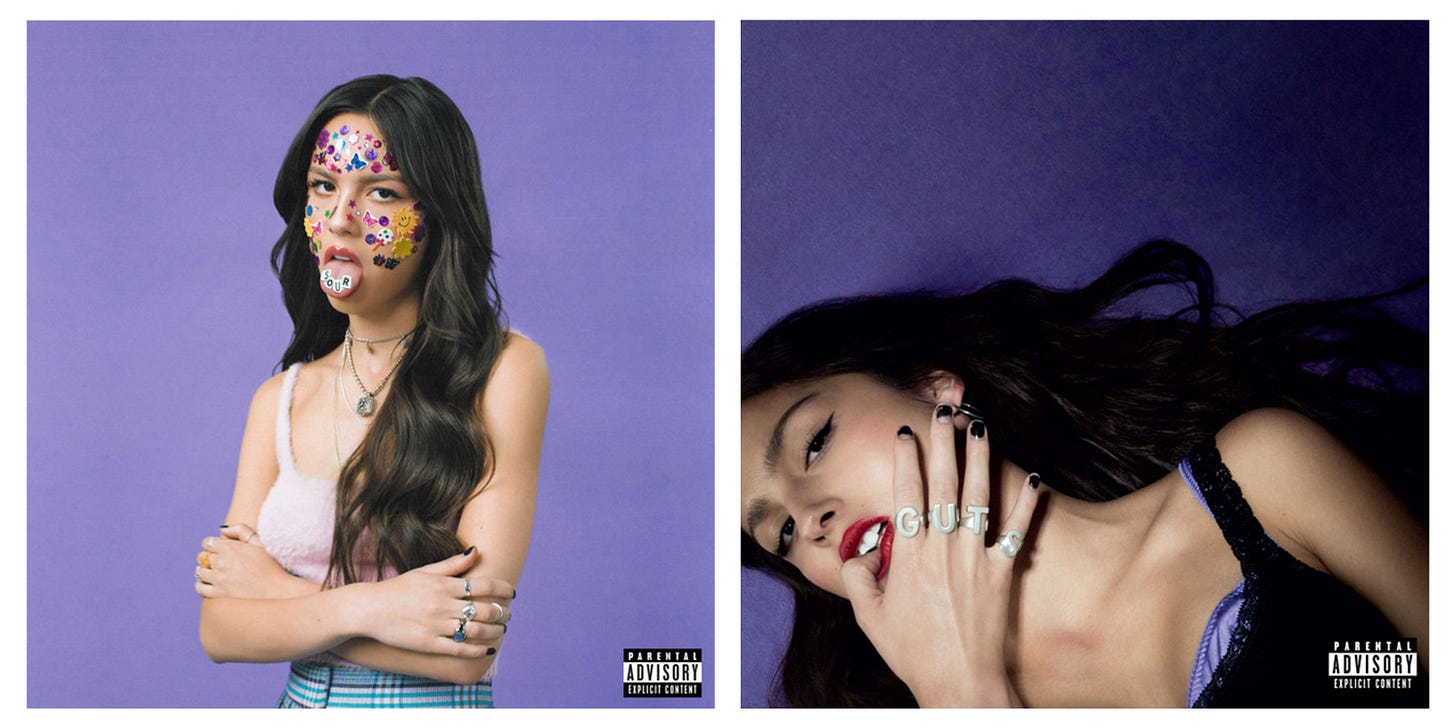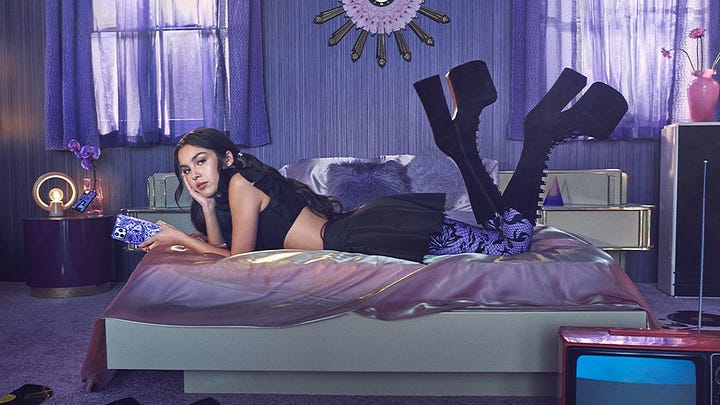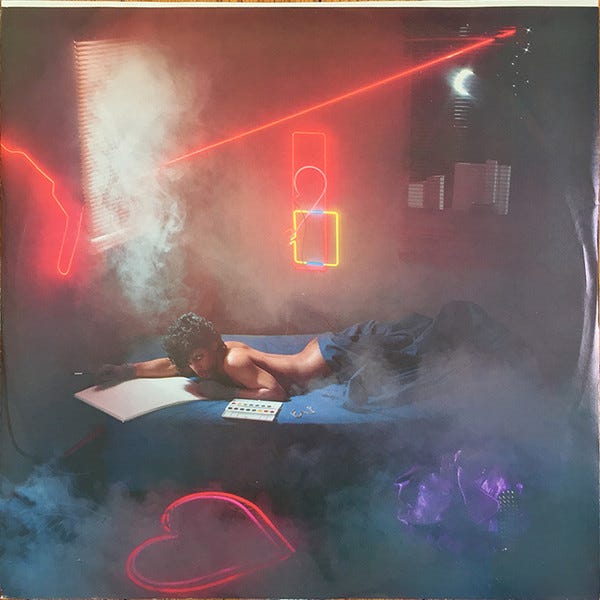Purple Reign
Comparing how the color has been used between rock legend Prince and Gen-Z popstar Olivia Rodrigo
The history of the color purple dates back to 48 B.C. and finds itself among tales of opulence and royalty. In The Secret Lives of Color, author Kassia St. Clair writes, “To be born into purple was to be born into royalty, after the Byzantine custom of bedecking the royal birthing chambers with porphyry and Tyrian cloth so that it would be the first thing the new princelings saw… Purple’s special status wasn’t confined to the West. In Japan a deep purple, murasaki, was kin-jiki, or a forbidden color, off-limits to ordinary people.”
A little over two thousand years later, a musician named Prince Rogers Nelson appropriately used a purple cursive script on the cover of his 1979 eponymous LP, Prince. From that instant on, the color continued to appear on covers throughout his career, whether in small details, like on 1988’s Lovesexy, or the entire square canvas for 1999. Most famously, Prince cemented his affiliation with the hue with the soundtrack and film Purple Rain. The singer’s use of purple exudes a sensual attitude, pairing the hue with images of him showing some skin and with hit sexy singles like “Kiss” and “Soft and Wet.”

He’s dubbed “The Purple One,” and in 2017, Pantone created the official color, “Love Symbol #2”, in memory of the late musician. According to Vanity Fair, Troy Carter, on behalf of the Prince Estate, commented, “The color purple was synonymous with who Prince was and will always be. This is an incredible way for his legacy to live on forever.” In 2018, the musician’s estate filed a motion to trademark the color, which is still currently pending.
If the trademark were ever to be approved, it could prove troublesome for Gen-Z icon, Olivia Rodrigo, who has also claimed the color purple in her rise to fame over the past two years. While just at the beginning of her career, the Disney Channel actress turned popstar has secured three Grammys (which she accepted in a black corset-like dress with sparkly purple detailing) and is the 19th most listened-to musician in the world on Spotify. Last month, Rodrigo released GUTS, the follow-up to her 2021 debut album Sour. Besides sharing the same pop-punk meets ballad mentality, the two albums also share purple album covers.

On the cover of Sour, Rodrigo gives off a youthful, lackadaisical demeanor, her face covered in stickers as if at a sleepover, casually sticking her tongue out all against a light shade of purple. While her sophomore album, GUTS, presents her and the color in a darker, more mysterious tone. Her use of purple here starts to lean more Prince, giving hints of a burgeoning sexuality, with a sliver of a bra peeking out from her dress as she playfully bites her fingers.
With both album releases, Rodrigo also starred in two commercial campaigns. In 2021, she partnered with CASETiFY, releasing purple phone cases on behalf of Sour. In the campaign imagery, we see Rodrigo lounging about in a purple-decorated bedroom filled with silk sheets, vintage TVs, and broken vinyl records. Last month, after the release of GUTS, Olivia unveiled a collaboration with Sony for the LinkBuds S campaign. Again, we see the singer pictured in yet another purple bedroom, which then expands into an entire purple house.


Outside of using synesthesia to define album color palettes, there are few musicians throughout history who have used one color to define their entire discography. Besides Prince and Rodrigo, my train of thought immediately goes to the 2000s rock duo The White Stripes. When searching the group, a flood of red, white, and black imagery takes over your perception. From album covers, to press photos, stage outfits, and more, Meg and Jack White only exist within this three-color palette. When Jack later began his solo project, he maintained a similar colorful branding approach but swapped blue for red. Coincidentally, in an interview with The New York Times, Olivia names Jack as one of her idols, referencing advice he wrote her in the form of handwritten notes. While no doubt musically inspired by Jack, it can only be assumed that Rodrigo also took note of her idol’s branding.
At the start of 2022, writer Alana Pockros investigated how consumer brands have sought out Gen-Z through the use of lilac purple. Pockros cites Rodrigo’s Sour album cover as evidence of that trend, but in general, makes the larger point that just like light pink was the generational color for millennials, so too is lilac for Gen-Z. The thesis makes me think that while Rodrigo is the first musician since Prince to use the color purple, her team’s intention is not necessarily to steal the rock legend’s sexual aura but to state her mark as the Gen-Z pop star. As this younger generation grows from outspoken social activists into more fluid adults, so too will Olivia and her imagery. Looking into the future, I’ll be interested to see if Rodrigo continues to use purple as a way to mark her legacy, and how it might affect the color within the visual history of music.
The Art of Cover Art is a free educational and inspirational resource. If you have $5/ month to spare, it would be very helpful in furthering my research. Or, if you think a friend might enjoy this newsletter, the best way to pay it forward is by sharing!




wsgn called "digital lavender" the color of 2023 !! https://www.wgsn.com/en/blogs/color-of-2023-digital-lavender